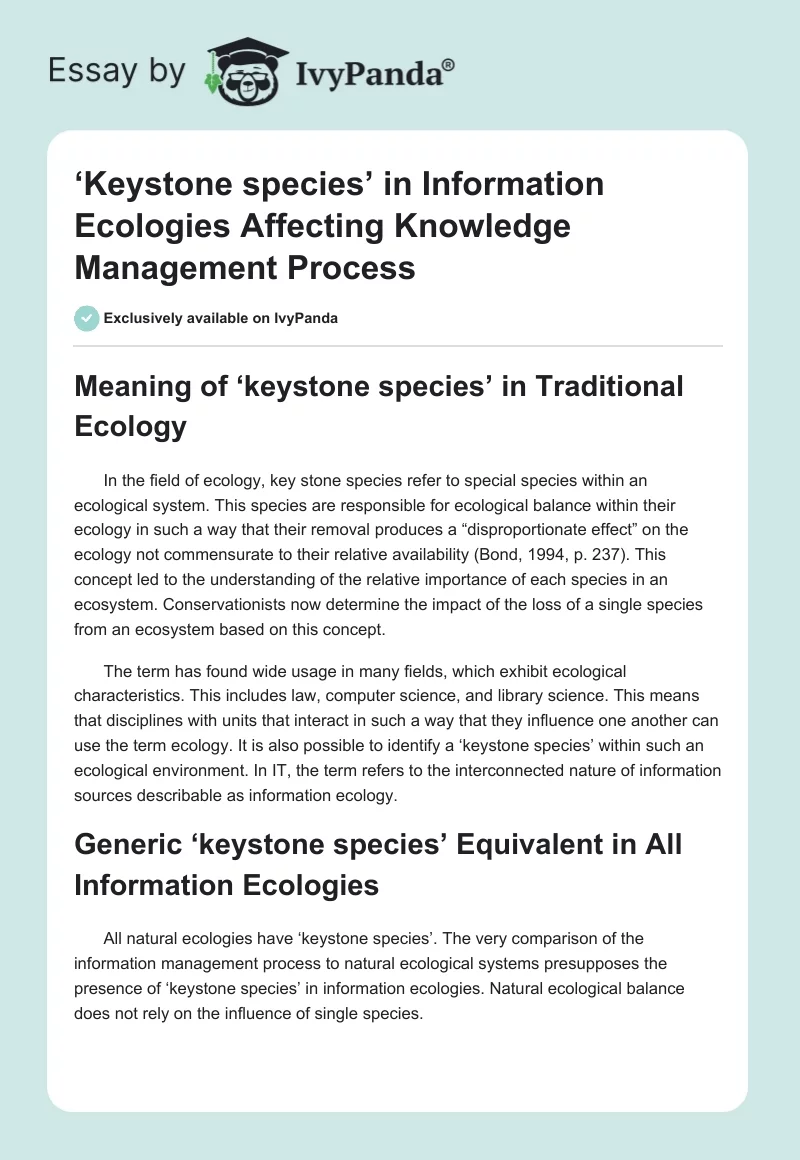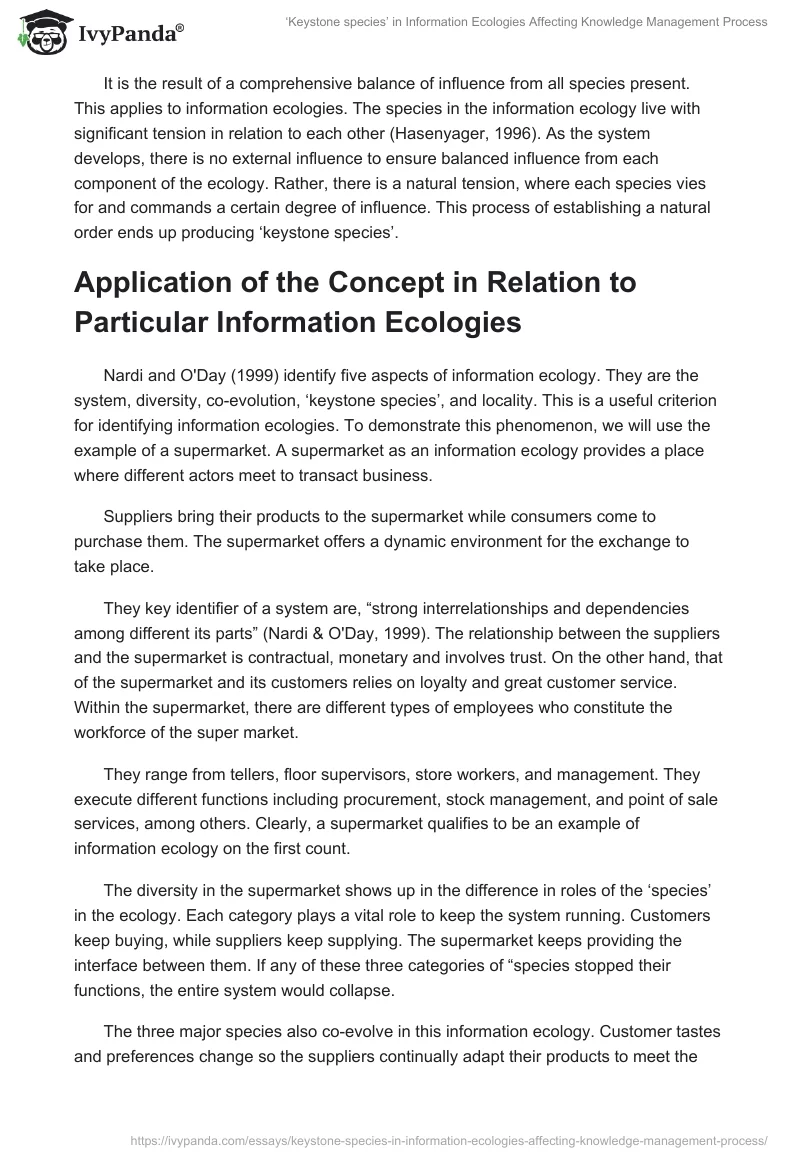Meaning of ‘keystone species’ in Traditional Ecology
In the field of ecology, key stone species refer to special species within an ecological system. This species are responsible for ecological balance within their ecology in such a way that their removal produces a “disproportionate effect” on the ecology not commensurate to their relative availability (Bond, 1994, p. 237). This concept led to the understanding of the relative importance of each species in an ecosystem. Conservationists now determine the impact of the loss of a single species from an ecosystem based on this concept.
The term has found wide usage in many fields, which exhibit ecological characteristics. This includes law, computer science, and library science. This means that disciplines with units that interact in such a way that they influence one another can use the term ecology. It is also possible to identify a ‘keystone species’ within such an ecological environment. In IT, the term refers to the interconnected nature of information sources describable as information ecology.
Generic ‘keystone species’ Equivalent in All Information Ecologies
All natural ecologies have ‘keystone species’. The very comparison of the information management process to natural ecological systems presupposes the presence of ‘keystone species’ in information ecologies. Natural ecological balance does not rely on the influence of single species.
It is the result of a comprehensive balance of influence from all species present. This applies to information ecologies. The species in the information ecology live with significant tension in relation to each other (Hasenyager, 1996). As the system develops, there is no external influence to ensure balanced influence from each component of the ecology. Rather, there is a natural tension, where each species vies for and commands a certain degree of influence. This process of establishing a natural order ends up producing ‘keystone species’.
Application of the Concept in Relation to Particular Information Ecologies
Nardi and O’Day (1999) identify five aspects of information ecology. They are the system, diversity, co-evolution, ‘keystone species’, and locality. This is a useful criterion for identifying information ecologies. To demonstrate this phenomenon, we will use the example of a supermarket. A supermarket as an information ecology provides a place where different actors meet to transact business.
Suppliers bring their products to the supermarket while consumers come to purchase them. The supermarket offers a dynamic environment for the exchange to take place.
They key identifier of a system are, “strong interrelationships and dependencies among different its parts” (Nardi & O’Day, 1999). The relationship between the suppliers and the supermarket is contractual, monetary and involves trust. On the other hand, that of the supermarket and its customers relies on loyalty and great customer service. Within the supermarket, there are different types of employees who constitute the workforce of the super market.
They range from tellers, floor supervisors, store workers, and management. They execute different functions including procurement, stock management, and point of sale services, among others. Clearly, a supermarket qualifies to be an example of information ecology on the first count.
The diversity in the supermarket shows up in the difference in roles of the ‘species’ in the ecology. Each category plays a vital role to keep the system running. Customers keep buying, while suppliers keep supplying. The supermarket keeps providing the interface between them. If any of these three categories of “species stopped their functions, the entire system would collapse.
The three major species also co-evolve in this information ecology. Customer tastes and preferences change so the suppliers continually adapt their products to meet the emerging needs. Supermarkets also constantly adapt their systems to ensure that the customers get the best possible services. In the past, all supermarkets relied on tills and all customers bought using cash. Now, they have credit and loyalty cards that make purchasing goods easier. Some even accept bank credit and debit cards.
The fourth condition Nardi and O’Day (1999) specified is the presence of ‘keystone species’. In a supermarket, the customers and to some extent the suppliers are the ‘keystone species’. No matter how efficient and well organized a supermarket is, it will only survive for a couple of months if no one bought goods from it.
If you remove the customers from the equation, the ecology becomes extinct. On the other hand, if suppliers refused to bring their goods to a particular supermarket, the same result follows. The removal of the supermarket from the ecology complicates the arrangement between the suppliers and the customer. However, they have the option of making alternative arrangements to continue with their relationship. The ecology can survive after the removal of the supermarket but not any other member of its system.
The final condition is locality. The supermarket is a fixed place and clients come to meet there. The technological systems that allow for the continuation of the complex relationships exist there.
What the Attempt to Apply this Concept Tell us About the General Idea of “Information Ecologies”
There are two major lessons we learn from the application of this concept. The first lesson is the similarity of human interaction with other natural interactions between species. It is amazing just how similar man made systems mimic natural systems complete with the consequences.
Technology remains the greatest expression of the advancement of human society. Therefore, finding this kind of similarity between nature and human endeavor provides impetus for us humans to pay more attention to nature because it still holds solutions to our problems.
The second lesson is that it tells us that systems rely on certain key players, the ‘keystone species’, without whom the whole system crumbles. The practice of information management will benefit from identifying the ‘keystone species’ in all information ecologies to ensure that the role they play remains protected. It is clear that anything short of this may result in an ecological disaster.
Costs and Benefits of This Approach
The cost associated with this approach is that it may lead to the impression that some of the information ecology components are not critical. This assumption may lead to neglect of vital functions while seeking to protect the ‘keystone species’. The key thing in the relationships is to remember that all components matter.
Their influence varies, but removal of any one of them affects the ecology somewhat. The second cost is the difficulty of identifying the ‘keystone species’. They are not necessarily the largest or the most obvious. Finding them requires careful observation.
“Keystone species are usually noticed when they are removed or they disappear from an ecosystem, resulting in dramatic changes to the rest of the community” (Illman, 1996). By then it may be late to save the ecosystem. In addition, they are complex, ambiguous, and non-linear (Baker & Bowker).
The key benefit of this approach is that it promotes systems thinking, which is very useful for analyzing modern day problems. It requires careful analysis of each component of the information ecosystem to determine its value and the possible consequences of its removal or destruction.
It is a very useful way of conducting risk analysis to decide on risk management measures. Its broad view encompassing not just human beings but equipment also provides a better way of determining the most efficient way to run processes, without causing harm to the information ecosystem.
Congruence in Terminology
The preferred position would be universal usage of terms by all persons concerned. This means that top management and IT managers should use similar terms when referring to the same things.
However, we must acknowledge that every trade has its lingo. As a specialist area, IT uses various terms that refer to certain elements of their work that have very different meanings for top managers who may be specialized in other fields. The redeeming quality of the term information ecology and its taxonomy is that it comes from a non-IT and non-management background.
This makes it a midpoint between the two extremes because either party must learn the meanings from the parent discipline. This probably gives a model that when applied will help to reduce the constant misunderstanding between IT managers and top managers. The concept provides a powerful model for understanding the forces that organize ecological communities, and it has influenced the thinking of managers and policy makers as they set priorities (Illman, 1996).
Reference List
Baker, K. S. & Bowker, G. C. (n.d.). Information Ecology: Open System Environment for Data, Memories, and Knowing. Web.
Bond, W. J. (1994). Keystone Species. In E.-D. Schulze & H. A. Mooney, Biodiversity and Ecosystem Function: (pp. 237-254). New York: Springer.
Hasenyager, B. W. (1996). Managing the Information Ecology: A Colaborative Approach to Information Technology Management. Westport CT: Greenwood Publishing.
Illman, D. L. (1996). Keystone Species Hypothesis. Retrieved from Pathbreakers: A Century of Excellence in Science and Technology at the University of Washington.
Nardi, B. A. & O’Day, V. L. (1999). Information Ecologies. First Monday: Peer Reviwed Journal on the Internet, IV (5).


